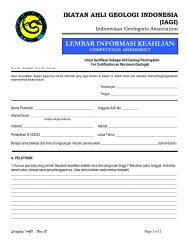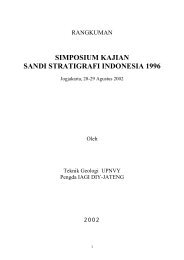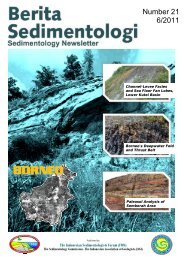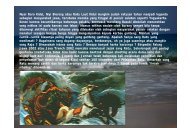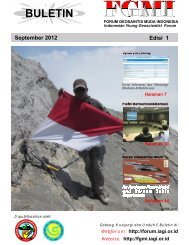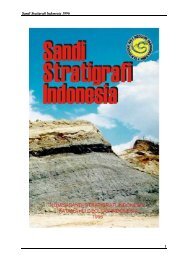Re-defining the allochthon in Timor: Tim Charlton & Dino Gandara
Re-defining the allochthon in Timor: Tim Charlton & Dino Gandara
Re-defining the allochthon in Timor: Tim Charlton & Dino Gandara
You also want an ePaper? Increase the reach of your titles
YUMPU automatically turns print PDFs into web optimized ePapers that Google loves.
<strong>Re</strong>‐<strong>def<strong>in</strong><strong>in</strong>g</strong> <strong>the</strong> <strong>allochthon</strong> <strong>in</strong> <strong><strong>Tim</strong>or</strong>:<br />
Structural‐stratigraphic relationships at <strong>the</strong><br />
boundaries of <strong>the</strong> Lolotoi metamorphic complex <strong>in</strong><br />
<strong><strong>Tim</strong>or</strong>‐Leste, and implications for <strong>the</strong> Mutis Complex<br />
<strong>in</strong> <strong><strong>Tim</strong>or</strong> Barat, NTT<br />
<strong>Tim</strong> <strong>Charlton</strong> & D<strong>in</strong>o <strong>Gandara</strong><br />
charlton@manson.demon.co.uk<br />
New website: www.timcharlton.co.uk
Tectonic models for <strong><strong>Tim</strong>or</strong><br />
(modified from <strong>Re</strong>ed et al., 1996)
<strong>Charlton</strong> et al. (1991)<br />
Harris et al. (1998)
<strong>Charlton</strong> (2002, slightly modified)<br />
Standley & Harris (2009)
Onset of arc‐cont<strong>in</strong>ent collision<br />
‐ potential orig<strong>in</strong>s of metamorphic complexes<br />
Banda<br />
Arc<br />
Collisional<br />
metamorphism<br />
Australia<br />
‘Asian’<br />
basement<br />
Australian<br />
basement
Lolotoi ‘type’<br />
massif
New Suai cross‐section
<strong>Charlton</strong> (2002).<br />
Orig<strong>in</strong>al boundary<br />
mapp<strong>in</strong>g by Grady &<br />
Berry (1977)
Previous arguments for an Australian<br />
basement orig<strong>in</strong> for <strong>the</strong> Lolotoi Complex<br />
• Gravity <strong>in</strong>dicates high‐density ‘roots’<br />
• Lolotoi Complex extends from >1000m.a.s.l.<br />
to >2900m subsea beneath <strong>the</strong> Suai Bas<strong>in</strong><br />
• <strong>Re</strong>ported stratigraphic contacts with<br />
Australian cover sequences<br />
• Basement‐cover relationships => Cribas<br />
Anticl<strong>in</strong>e is basement‐cored
The Mutis‐Lolotoi correlation
‘…<strong>the</strong>re is no significant difference <strong>in</strong> composition<br />
between <strong>the</strong> Lolotoi and Mutis Complexes’ (Harris,<br />
2006)<br />
But…<br />
• P‐T conditions more restricted <strong>in</strong> Lolotoi (no granulite)<br />
• Different tim<strong>in</strong>g (e.g. zircon ages L ~83Ma; M ~35Ma)<br />
• Composition (e.g. quartz <strong>in</strong> metabasites L ~30%, M ~15%; <strong>in</strong><br />
metapelites L typically >40%, M typically
Lolotoi<br />
Lu‐Hf weighted mean age of 45.4 ±<br />
0.7 Ma from garnets: <strong>in</strong>terpreted<br />
to represent peak metamorphism<br />
of Lolotoi Complex (Standley,<br />
2007)<br />
Harris (2006)<br />
Mutis<br />
Aileu
Chang<strong>in</strong>g def<strong>in</strong>itions of <strong>the</strong><br />
<strong>allochthon</strong>
Audley‐Charles (1968)
Audley‐Charles (1981)
Harris (2006)
Haig et al. (2006)
<strong>Charlton</strong> (post‐2002)
The geometry of an <strong>allochthon</strong>
Harris et al. (1998)<br />
Standley & Harris (2009)
Field evidence<br />
Sou<strong>the</strong>rn front of <strong>the</strong> Lolotoe<br />
‘type’ massif
Audley‐Charles (1968)
Lolotoi boundary on<br />
<strong>the</strong> Ogues map sheet<br />
<strong>Re</strong>connaissance<br />
mapp<strong>in</strong>g based on<br />
limited fieldwork and<br />
Google Earth<br />
<strong>in</strong>terpretation
Three‐way stratigraphic l<strong>in</strong>kage<br />
• Dartollu Formation unconformably on Lolotoi<br />
Complex<br />
• Maubisse Formation unconformably on<br />
Lolotoi Complex<br />
• Maubisse fragments reworked <strong>in</strong>to Dartollu<br />
‐ Maubisse Formation is def<strong>in</strong>itely Australianaff<strong>in</strong>ity<br />
=> Lolotoi (and Dartollu) are also Australianaff<strong>in</strong>ity
Lunt (2003)<br />
Lunt (2003)<br />
Pellatispira <strong>in</strong> Eocene<br />
conglomerate with<br />
Triassic limestone<br />
clasts<br />
Dartollu Lst conta<strong>in</strong>s<br />
reworked Australianaff<strong>in</strong>ity<br />
Maubisse Fm.<br />
fragments<br />
Co-occurrence of<br />
Biplanispira and<br />
Lacaz<strong>in</strong>ella <strong>in</strong> same<br />
th<strong>in</strong> section<br />
Assil<strong>in</strong>a <strong>in</strong> Sahul<br />
Shoals-1 well
Legumau Range
Audley‐Charles<br />
(1968)
‘Barique Formation’
Audley‐Charles (1968)
‘Barique<br />
Volcanics’
Sou<strong>the</strong>rn front of <strong>the</strong> Laclubar/<br />
Bebe Susu massif
Audley‐Charles (1968)
Standley & Harris (2009)
Caraulun‐Same and Mota Siu<br />
reconnaissance mapp<strong>in</strong>g
Cablac‐Lolotoi relationships on Mount Cablac<br />
(Keep et al., 2009)
Conclusions from fieldwork<br />
• Lolotoi Complex represents Australian<br />
cont<strong>in</strong>ental basement<br />
• Lolotoi Complex is overla<strong>in</strong> unconformably by:<br />
‐ Maubisse and Dartollu formations (proven)<br />
‐ Atahoc and Cribas formations (probable)<br />
‐ Cablac Formation (likely but not observed by us)<br />
• No equivalents of <strong>the</strong> Palelo Group observed<br />
<strong>in</strong> <strong><strong>Tim</strong>or</strong>‐Leste
An alternative <strong>in</strong>terpretation of Standley &<br />
Harris’s (2009) geochemical data is required<br />
Particularly...<br />
• Petrogenetic <strong>in</strong>terpretations<br />
• The significance of radiometric dat<strong>in</strong>g
‘Australian’<br />
‘Asian’
‘Asian’
Lolotoi<br />
Lu‐Hf weighted mean age of 45.4 ±<br />
0.7 Ma from garnets: <strong>in</strong>terpreted<br />
to represent peak metamorphism<br />
of Lolotoi Complex (Standley,<br />
2007) =Middle Eocene<br />
Harris (2006)<br />
=Late Cretaceous (Santonian‐Campanian)<br />
Mutis<br />
Aileu<br />
=Late Eocene
<strong>Re</strong>vised <strong>in</strong>terpretation
Buru<br />
Seram<br />
Banda metamorphic P‐T‐t conditions
Lolotoi Complex<br />
Mutis Complex<br />
Viete et al. (2011)
Compromise?<br />
Lolotoi Complex is Australian basement<br />
Is <strong>the</strong> Mutis Complex also derived from<br />
<strong>the</strong> Australian plate ra<strong>the</strong>r than <strong>the</strong><br />
Banda forearc?<br />
But <strong>the</strong>n <strong>the</strong> Palelo/Metan <strong>in</strong> West <strong><strong>Tim</strong>or</strong><br />
must also be Australian, non‐arc aff<strong>in</strong>ity
Tests<br />
• Mutis Complex<br />
‐ Geochemical aff<strong>in</strong>ities (to Lolotoi Complex; and to Banda volcanic arc or<br />
Australian rift‐spread<strong>in</strong>g volcanics)<br />
• Metan Volcanics<br />
‐ Arc or Australian geochemistry?<br />
‐ Palaeomagnetism<br />
• ‘Cablac Limestone’<br />
‐ Age: Mesozoic or Miocene?<br />
‐ Structural‐stratigraphic relationships to Mutis/Palelo<br />
• Dartollu Limestone (Eocene)<br />
‐ Does this unit occur <strong>in</strong> West <strong><strong>Tim</strong>or</strong>?<br />
‐ Structural‐stratigraphic relationships (e.g. to Metan volcanics)<br />
‐ Palaeomagnetism<br />
This work needs to be done <strong>in</strong> West <strong><strong>Tim</strong>or</strong>
Significance
Acknowledgements<br />
Roc Oil Company<br />
Limited<br />
SERN<br />
Pr<strong>in</strong>cipal field assistants:<br />
Hercio Fernandes Xavier (‘Iko’)<br />
Joao Soares<br />
Cleto Amaral<br />
Mario Nicolau<br />
Driver: Helder Amado Vieira
Terima Kasih<br />
Thank you<br />
Obrigadu





